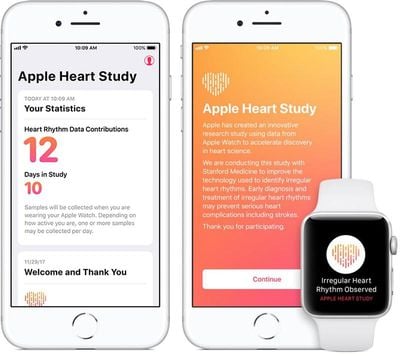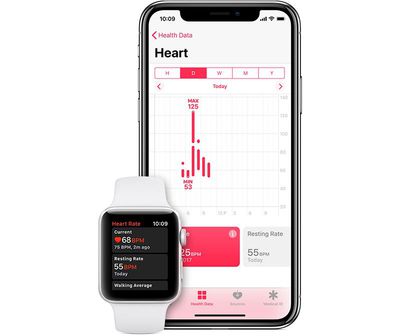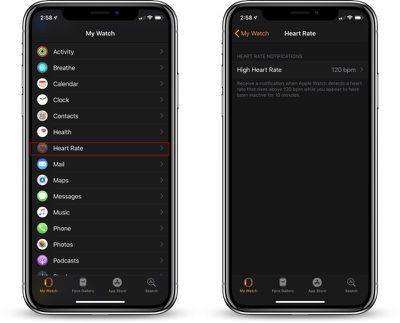Apple and Stanford University's School of Medicine are no longer allowing new participants to join the joint heart rate study that they're conducting using data gathered from the heart rate monitor of the Apple Watch, according to an updated notice on the Apple Heart Study website.
As of August 1, 2018, an enrollment termination date Apple and Stanford first announced when the study launched, enrollment is officially closed. While enrollment has ended, the study does not end until January 31, 2019, and Apple plans to continue collecting data from current participants until the completion of the study.

Note: Enrollment for this study is closed to new participants as of August 1, 2018. If you are currently enrolled, your participation will continue until the end of the study.
The Apple Heart Study is designed to use data from the Apple Watch to identify irregular heart rhythms to determine whether the wrist-worn device can accurately detect life-threatening conditions like atrial fibrillation.
The study was previously open to anyone in the United States who was 22 years older with an iPhone 5s or later and an Apple Watch Series 1 or later.
Participants were instructed to download and install the Apple Heart Study app and wear the Apple Watch. When an irregular heart beat is detected in a study participant, a consultation with a Study Telehealth provider from American Well is offered, with some people asked to wear an ePatch monitor for up to seven days for further investigation.
One MacRumors reader shared his story using the Heart Rate Study app and the accompanying patch after an abnormal rhythm was detected:
I believe that many of you don't understand just how much effort and expense Apple has spent on developing this research program. I signed up late last year, and several weeks ago they notified me that they had read an irregular heart rhythm on my app.
I called them, talked to a Dr. on line, they sent me a state of the art medical monitor the size of an Apple watch which is applied with a sticky tape over my heart for 7 days, I kept it attached for a week, sent it back (post payed) and they contacted me within 3 days, they had me contact one of their research Drs. who went over the results of the week long monitor, they saw no further arrhythmia, and gave me confidence that the earlier abnormal pattern was not a problem, readings showed my heart strong, and healthy.
With the study now closed to new participants, the Apple Heart Study app has been removed from the App Store. Apple has also removed its dedicated Apple Heart Study webpage from its site.
Apple's Heart Rate Study in collaboration with Stanford Medicine first launched in November 2017. Atrial fibrillation, a common form of heart arrhythmia that is covered in the study, can indicate serious medical conditions like heart failure and stroke. Afib affects millions of people but often goes undiagnosed, with the study aiming to determine if the Apple Watch is able to alert people of this dangerous condition and accompanying health problems.
Other studies conducted by the team behind the Cardiogram app and researchers at the University of California, San Francisco have suggested that the Apple Watch is able to detect an abnormal heart rhythm with 97 percent accuracy. It may also be useful in detecting early signs of other diseases like diabetes, hypertension, and sleep apnea.

Currently, the heart rate monitor built into the Apple Watch (Series 1 models and later) will send an alert if a faster-than-normal resting heart rate is detected, a feature that has saved multiple lives. This heart rate monitoring option can be activated by opening up the Apple Watch app on the iPhone, selecting the heart rate app, and setting your high heart rate notification to the desired level.

While the Apple Watch sends alerts for a high heart rate, it does not notify people of abnormal rhythms or other issues that have been detected, but that could change in the future depending on the outcome of the study.
Rumors have suggested that 2018 Apple Watch Series 4 models will include enhanced heart rate detection features that could bolster the Apple Watch's ability to detect diseases linked to higher heart rates and abnormal heart rhythms, but it is not entirely clear what the enhanced heart rate features consist of.
New Apple Watch models, which are expected in September alongside the 2018 iPhones, are also said to include a new design with a 15 percent larger display.
























